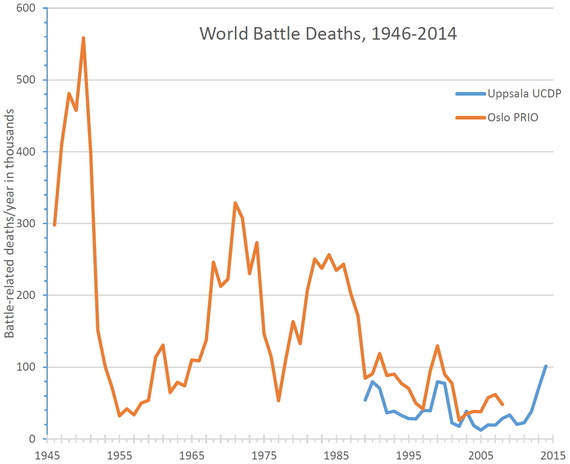The latest Swedish data on world battle-deaths (through 2014) add to the evidence of a serious reversal of the decades-long trend toward fewer and smaller wars.
From fewer than 25,000 battle-deaths in 2011, the total has jumped to nearly 40,000 in 2012, 70,000 in 2013, and more than 100,000 in 2014. The world has moved from a historic interlude of relative peace, about halfway back to Cold War levels of armed conflict, and will get there in a few more years on the present trajectory. (The Swedish Uppsala battle-death data, UCDP, are minimums based on confirmed reports of incidents.)
Most of the reversal in the peaceful trend over the past decade has come specifically from the terrible civil war in Syria, and the consequent new Iraqi war with the so-called Islamic State (IS). Of the world's 101,000 battle-deaths in 2014, some 54,000 were in Syria and 13,000 more in Iraq, together making up close to two-thirds of the world total.
Afghanistan and Pakistan each added another 12,000 battle-deaths; Nigeria and Ukraine had about 5,000 each. Smaller wars with 1,500 to 2,000 battle deaths included South Sudan, Yemen, and Israel/Hamas. Adding this year's developments into the picture, the civil wars in Yemen and South Sudan have worsened dramatically in 2015, with millions of people facing starvation unless solutions are found.
The world's most serious wars are quite internationalized. Foreign fighters and outside military forces are operating in Syria, Iraq, Afghanistan, Nigeria, Ukraine, South Sudan, and Yemen. By contrast, United Nations or other international peacekeepers are conspicuously absent from the world's major conflicts today, the main exception being South Sudan where they are ineffective. (It's unclear if these conflicts became deadlier because of the absence of peacekeepers or if the world's powers avoid using peacekeepers in the deadliest conflicts.)
The increase in war over the last four years does not negate the longer-term decline in armed conflict, but does clearly set the shorter-term trend in the other direction, with the potential to undo much past progress if things continue in the new way. Battle-deaths in 2014 were still less than half the typical level during the Cold War years, and of course no comparison to the World Wars. In the peaceful post-Cold War period, we've had two previous spikes in battle-deaths up to near the level reached in 2014. These corresponded with the Ethiopian civil war and Gulf War around 1991, and the Ethiopia-Eritrea War around 1999 -- the world's last sustained interstate war.
Because quantitative data are always suspect in some quarters, and battle-deaths are in some ways problematic, I've argued the long-term decline of armed conflict since the World Wars primarily using evidence other than just battle-deaths.
Among the salient landmarks are the "zeroes" -- no nuclear wars since 1945, no wars between great powers since 1953, no naval battles worldwide for more than 25 years, no tank battle anywhere for more than 10 years, no wars between two regular state armies (the most destructive category) in more than 10 years. And the rising great power, China, has not fought a single military battle in more than 25 years (historically unheard of). Geographically, the areas of the world affected by active fighting have shrunk to a zone from central Africa through Pakistan. Whole regions such as Central America and Southeast Asia, not long ago plagued with multiple wars at once, are nearly entirely at peace now.
As battle-deaths climb, however, some of the other peaceful developments also seem to be slipping. The war in Ukraine crosses several red lines, including the spread of active war up into Europe and the de facto fighting between two regular uniformed armies, although dressed up as local conflict and "little green men." It's not quite an interstate war, but it's pushing the limits. Meanwhile, Russia's annexation of Crimea was an alarming breach, unprecedented in decades, in which one UN member seizes and annexes the territory of another. Iraq tried that with Kuwait but unsuccessfully.
Even China's remarkable "peaceful rise" seems to be slipping lately, with more bellicose rhetoric and expansive claims in the South China Sea -- where China says everything belongs to China and therefore is not subject to international law. So far, China is not an important contributor to the new trend away from peace, but China's changing attitude does somewhat undermine the fragile norms of peace that had been strengthening.
Syria and the adjacent Sunni areas of Iraq, consisting of less than half of one percent of the world's land area, currently produce two-thirds of the world's bloodshed from armed conflict. Americans wishing to help the millions of Syria refugees directly can do so through the UN refugee agency here. Diplomatic efforts for a political settlement need to be redoubled and supported.
Note: I've updated my "wars in progress" page with the 2014 data.
Sources: UCDP Battle-deaths data, v.5, 2015. See Pettersson, Therése & Peter Wallensteen. Armed Conflicts, 1946-2014. Journal of Peace Research 52(4), 2015. Available at http://www.pcr.uu.se/research/ucdp/datasets/ucdp_battle-related_deaths_dataset/ . PRIO data: Peace Research Institute Oslo, Battle Deaths Dataset 3.0, updated from Bethany Lacina and Nils Petter Gleditsch, "Monitoring Trends in Global Combat: A New Dataset of Battle Deaths", European Journal of Population 21, no. 2-3 (2005). Data provided by Human Security Report Project (HSRP), Simon Fraser University.

